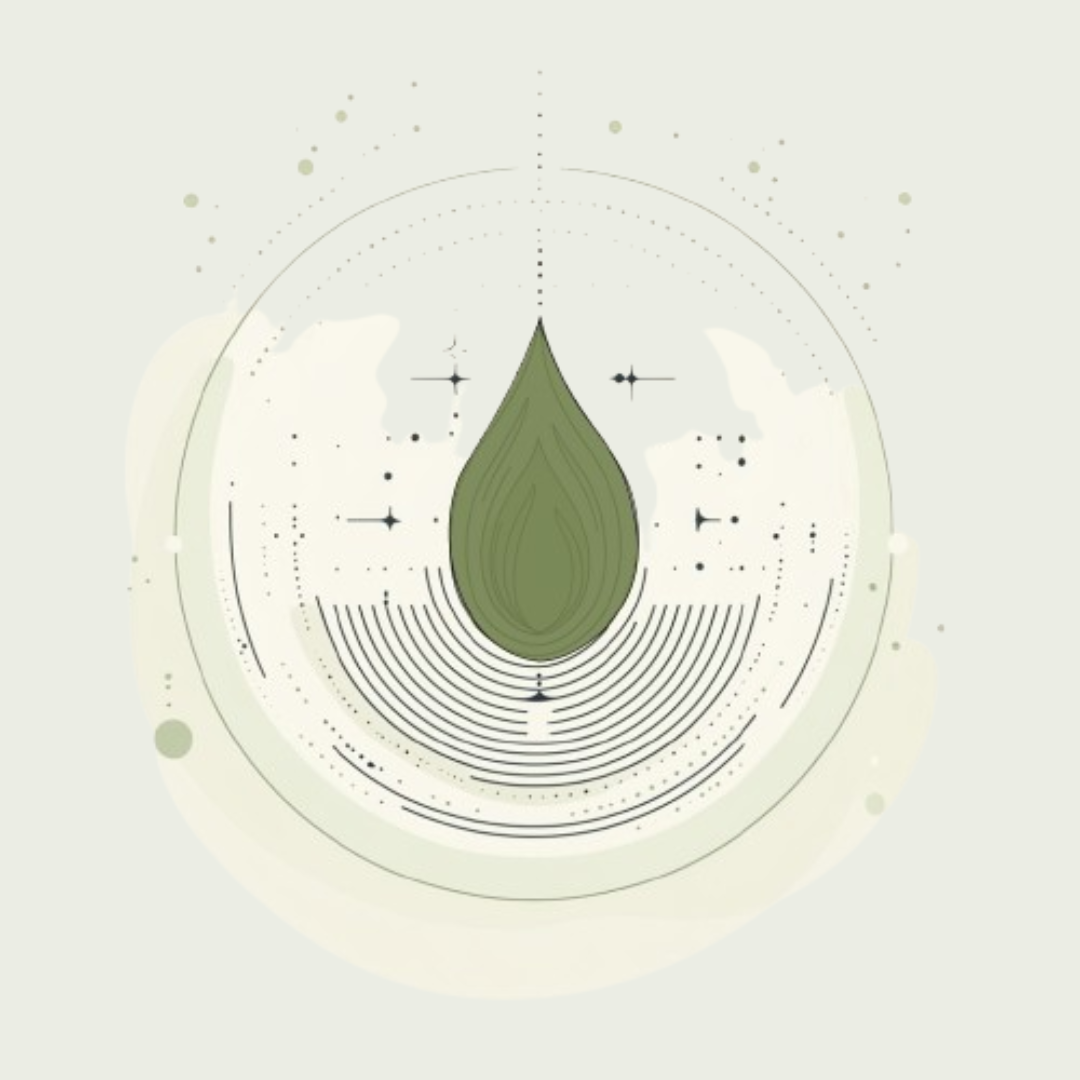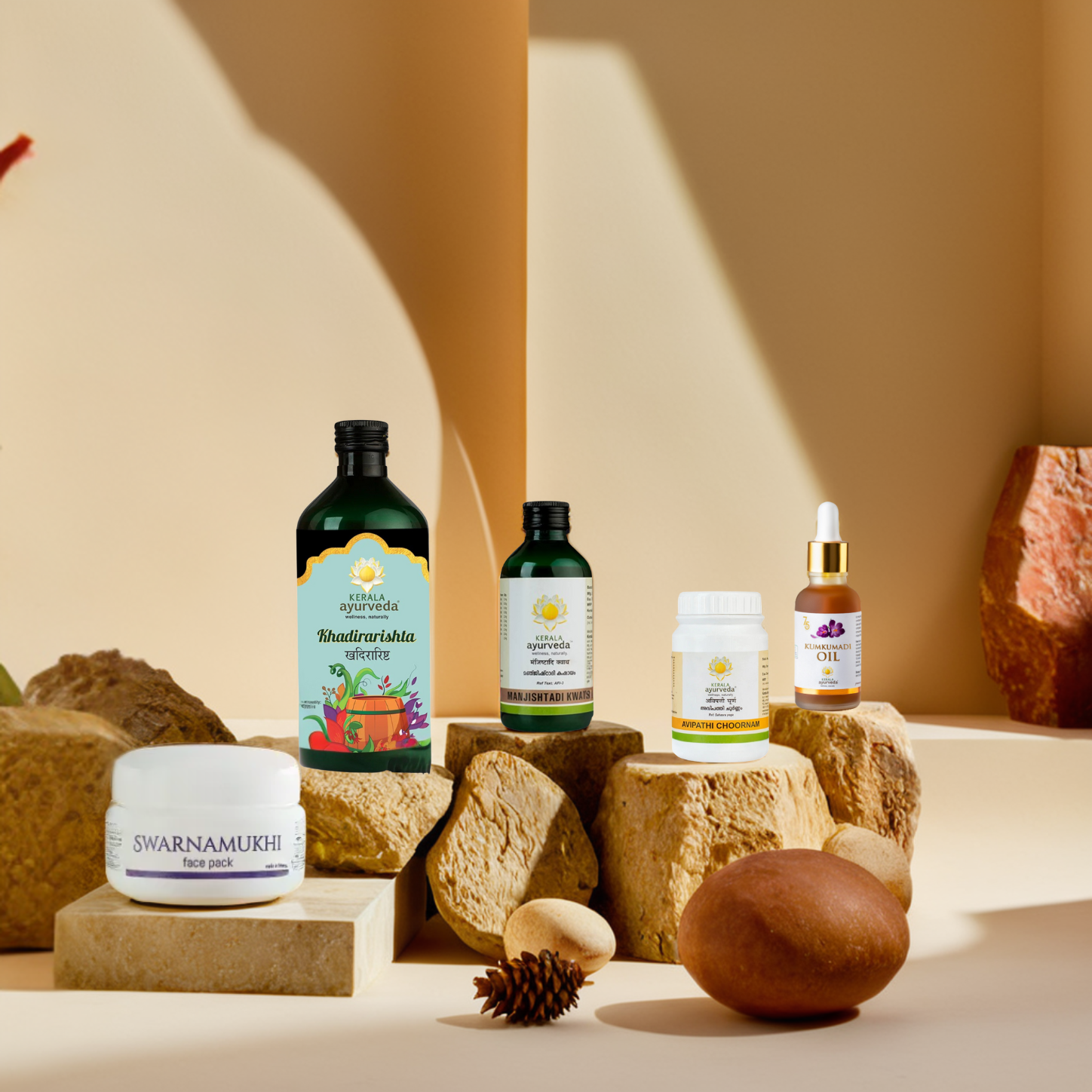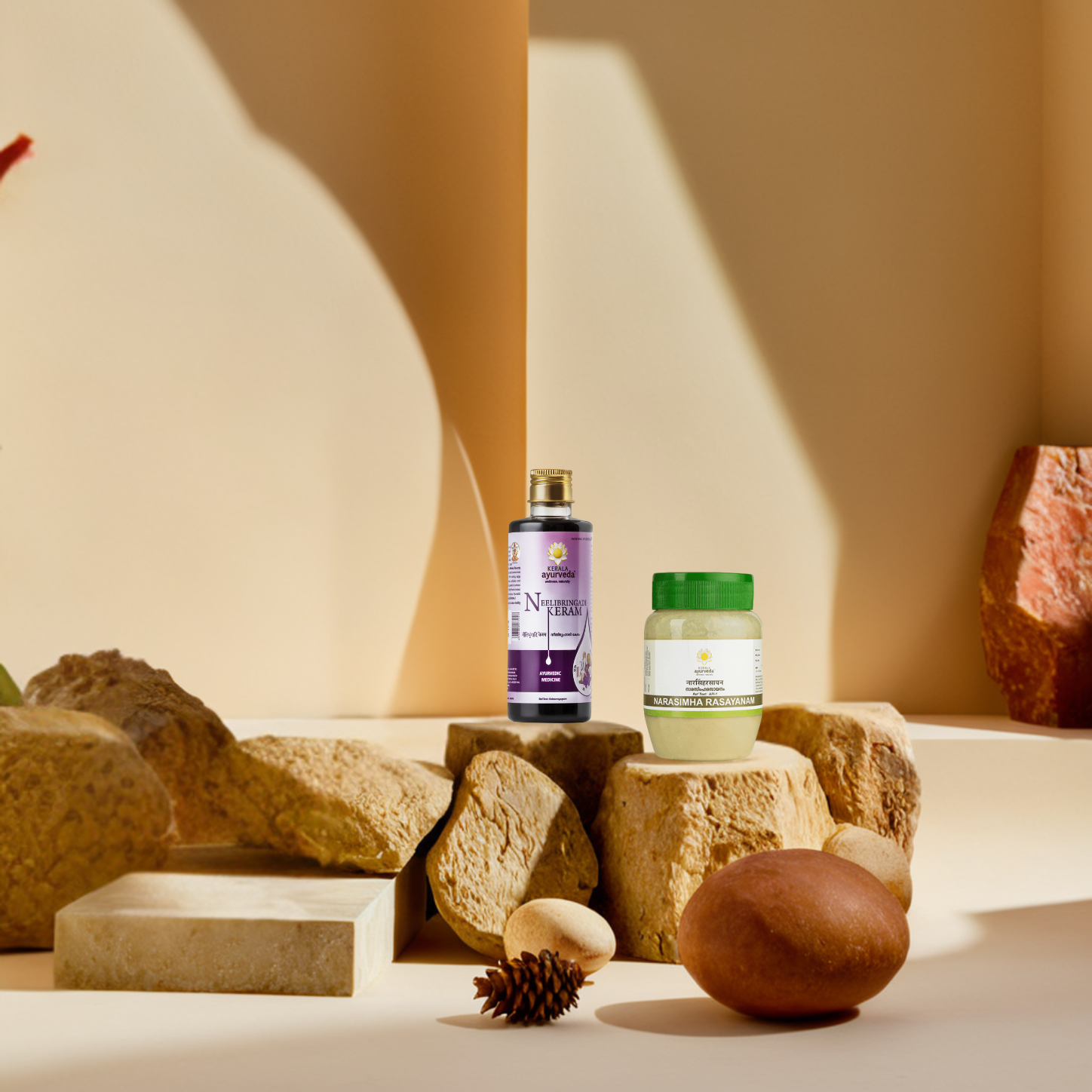Highlights
Ever wake up to skin that feels completely different from the day before? Some mornings it’s glowing and calm, and other times it’s dry, dull, or breaking out without warning. While it’s tempting to blame a bad night’s sleep or that extra piece of dessert, skin health usually runs much deeper. Every day, things like the weather, screen time, your meals, and even your mood quietly affect how your skin behaves.
With so many products claiming to be the next big thing, it’s easy to get stuck in a cycle of trial and error, especially when they only work for a while or make things worse. That’s where Ayurveda comes in with a gentler, more thoughtful approach. It doesn’t just treat what’s on the surface; it works from the inside out, helping to bring your skin back to balance, calm, and natural radiance.
Here’s how Ayurveda can help your skin feel and look its best, without harsh steps or complicated routines.
Understanding Your Skin Type
According to Ayurveda, your skin reflects what’s happening inside. When your digestion and nutrition are off, your Rasa Dhatu (plasma tissue) takes the hit, and your skin starts showing signs. That’s why knowing your dominant dosha can make a big difference in how you care for your skin.
- If you're Vata-dominant, your skin likely feels dry and rough. It craves deep moisturisation, and herbs like Ashwagandha can work wonders.
- If Pitta rules your system, your skin might be oily, sensitive, and quick to react. Soothing ingredients like Aloe Vera help calm and cool it down.
- If you have more Kapha, chances are your skin leans oily and acne-prone. Regular exfoliation keeps it fresh and balanced.
Once you know your dosha, it’s much easier to choose skincare that actually works for you.
Common Skin Types
Your skin’s needs depend a lot on its natural type, which is influenced by your body's inner balance. In Ayurveda, each skin type is linked to a specific Dosha, which explains why some skin stays dry, while others get oily or sensitive. Knowing your type is the first step to choosing the right care.
- Normal Skin: Balanced moisture and sebum levels, small pores, even tone, and soft texture. This skin type rarely reacts to products and becomes drier with age.
- Dry Skin: Lacks lipids, leading to flakiness, tightness, and irritation. Water loss and low sebum production reduce the skin’s ability to retain moisture.
- Oily Skin: Produces excess sebum due to hormones, genetics, or cosmetic use. Enlarged pores, acne, and a shiny appearance are common.
- Combination Skin: Characterized by an oily T-zone and dry cheeks. Sebum imbalance causes pores and minor breakouts in oily areas, while dry patches remain on others.
Ayurvedic Remedies for Skin Health
When your skin problems keep coming back, it’s usually a sign that something inside needs attention. That’s where Ayurvedic care can really help. It balances your body, clears out toxins, and helps your skin heal and stay healthy over time.
1. Start with a Clean Base
Good skin care begins with clean skin. Washing away dirt, oil, and leftover products gives your skin the space to breathe and recover. Ayurveda encourages gentle cleansing to support your body’s natural repair process.
2. Oil Massage (Abhyanga)
This is one of the most relaxing ways to care for your skin. A warm oil massage doesn’t just moisturize, it improves blood flow, supports deeper tissues, and leaves your skin feeling soft and refreshed. It also helps reduce dryness, tension, and fatigue from daily stress.
3. Natural Exfoliation
Scrubbing off dead skin cells helps your skin look fresh and feel smoother. Ayurveda uses simple kitchen ingredients that are kind to your skin:
- Salt: Great for rough areas like elbows, knees, or feet.
- Sugar: Works well on the face, especially if your skin is sensitive.
- Coffee: Helps tone the skin and may reduce stretch marks. You can even make small coffee cubes for easy use.
Ayurvedic remedies don’t require anything fancy. Just a few basic habits and natural ingredients can go a long way in helping your skin feel better and look clearer.
Ayurvedic Products for Skin Nourishment
Ayurveda offers specialized products made from natural herbs and oils, designed to treat and beautify skin gently and effectively. Kerala Ayurveda’s range is crafted with care, using authentic ingredients that bring therapeutic benefits without side effects.
1. Kumkumadi Oil
Kumkumadi Oil is treasured for its unique ability to address various skin concerns. Rich in saffron (known as Kumkuma in Sanskrit), it enhances skin glow while acting as a toner, cleanser, and moisturizer. Made from natural herbs and essential oils, Kumkumadi oil improves skin nourishment and radiance without irritation.
How to Use:
Step 1: Cleanse your face with a mild cleanser.
Step 2: Warm a few drops of oil in your palms and massage a thin layer on your face. You can also use a Gua Sha tool or a roller to disperse the oil over the face.
Step 3: Apply regularly at night for the best results. Wash off with a mild cleanser or lukewarm water the next morning.
Note: If you have oily or acne-prone skin, reduce the dose to 1-2 drops and wash off after 30 minutes.
2. Winsoria Oil
Winsoria Oil is an effective remedy for skin conditions like psoriasis, soothing itching and scaling without causing rashes or swelling. It blends plant-based ingredients that come from herbs, roots, flowers, and other parts of plants, known for their natural healing and skin-nourishing properties, like Manjishta, Vidphala, and Sariba, with a coconut oil base to reduce inflammation and skin discoloration safely.
How to Use:
Step 1: Take the required amount of Winsoria Oil in a bowl. Gently apply the oil to affected areas 2-3 times daily.
Step 2: Let it sit for about 1 hour. Wash the area with a gentle cleanser and pat dry.
Note: Depending on the severity, the skin may take at least two weeks to a month to heal properly. For children, mix Winsoria Oil with equal parts of coconut oil.
3. Swarnamukhi Face Pack
This popular face pack exfoliates dead skin cells gently, improving smoothness and brightness. Made from herbs like Nagkesar, Lodhra, Yavya, and saffron, it clears pores and enhances blood circulation for youthful, vibrant skin.
How to Use:
- Make a paste in water or lime juice and apply as a thin layer evenly on the face.
- Leave it for 10 minutes, then wash and pat the face.
4. Mahathikthaka Ghritham (Internal Medication)
Mahathikthaka Ghritham helps treat skin diseases related to rashes, boils, and blood impurities. It also supports conditions like hyperacidity, gout, and chronic fevers by cleansing internal toxins and improving skin health from within.
How to Use:
The recommended dosage for adults is 5 to 10g. It can also be given to children in small quantities, say three to five grams, twice daily.
Note: It is recommended to take Mahathikthaka Ghritham with lukewarm water or as directed by the physician.
Diet and Lifestyle for Healthy Skin
Ayurveda emphasizes healing from the inside out. Skin health starts with digestion and lifestyle. Healthy skin isn’t just about what you apply; it's also shaped by what you eat and how your body digests it. In Ayurveda, the condition of your skin is closely tied to your digestion and daily habits.
1. Digestion Comes First
When your digestive fire (Agni) is strong, your body processes food well and keeps waste from piling up. But when digestion slows down, toxins (Ama) start building up, and this often shows up on your skin as breakouts, dullness, or irritation.
2. What Feeds Your Skin from Within
Your skin reflects the health of different parts of your body, especially the first few layers of tissue called Dhatus. These include:
- Rasa (plasma): Linked to hydration and overall skin glow
- Rakta (blood): Affects complexion and clarity
- Lasika (lymph): Supports cleansing and defense
- Mamsa (muscle): Gives your skin strength and tone
The more these tissues are affected, the more your skin may struggle. That’s why taking care of your digestion and daily routine can have such a visible impact.
Ayurveda keeps it simple: eat fresh, wholesome meals, avoid stress where you can, and follow a routine that supports balance. Your skin will thank you.
What to Eat for Glowing, Healthy Skin?
Making the right dietary choices can nourish your skin from the inside out. Here are the must-have items on your plate:
- Drink Enough Water: Your skin needs water just like the rest of your body. If you don’t drink enough, your skin can look dry, dull, and feel tight. Try to drink at least 8 glasses a day to stay hydrated and glowing.
- Eat Fatty Fish: Fish like salmon and mackerel are full of omega-3 fats, which help keep your skin soft and healthy. These fats also calm redness and prevent breakouts. Plus, they protect your skin from sun damage.
- Add Avocados: Avocados are rich in healthy fats that keep your skin moisturized and firm. They also contain nutrients that protect your skin from sun damage, one of the main causes of early aging.
- Snack on Walnuts: Walnuts have a great mix of omega-3 and omega-6 fatty acids. These are essential for keeping your skin smooth and calm. Just remember—not too much, as too many omega-6 fats can sometimes make skin problems worse.
- Include Tomatoes: Tomatoes are full of vitamin C and special antioxidants like lycopene that protect your skin from the sun and may help slow down aging. Cooked tomatoes (like in soups or curries) are even better, as they release more of these helpful compounds.
- Try Sunflower Seeds: These small seeds pack a big punch. A small handful gives you:
- Lots of Vitamin E helps protect your skin from damage
- Selenium supports healthy skin repair
- Zinc helps with healing and reduces breakouts
- A good amount of protein is important for skin strength
- Vitamin E is especially important because it acts as a powerful antioxidant that protects your skin from oxidative stress.
What to Avoid for Clearer, Healthier Skin?
Just as some foods nourish your skin, others can damage it over time. If you’re serious about maintaining a glowing complexion, steer clear of these common culprits:
- Say No to Blood-Sugar-Spiking Foods: White rice, sugary cereals, white bread, and pasta might be comfort foods, but they’re not doing your skin any favors. These foods spike your blood sugar levels, leading to inflammation and oil production, both of which can cause acne and dullness. If glowing skin is your goal, swap them out for whole grains, fruits, and fiber-rich veggies.
- Cut Back on Dairy Products: Dairy can be a trigger for many people dealing with acne or skin inflammation. Milk and cheese may stimulate certain hormones that encourage oil production, which in turn clogs pores. If you notice breakouts or irritation after consuming dairy, consider plant-based alternatives like almond milk, oat milk, or coconut yogurt.
Conclusion
When you care for your skin from the inside out, you give it the strength to stay clear, radiant, and resilient through every season of life. Eating nourishing foods, following mindful habits, and using herbal support rooted in tradition can help you achieve lasting skin health, not just surface-level glow.
At Kerala Ayurveda, you get authentic wellness solutions crafted with care, backed by centuries of Ayurvedic wisdom. Every product, whether it’s a herbal supplement, rejuvenating skin oil, or detox tea, is designed to support your body’s natural balance and promote glowing skin from within.
Start your Ayurvedic skin wellness journey today, explore our range of products, and feel the difference from within.
FAQs
1. What are some effective Ayurvedic home remedies for glowing skin?
A commonly recommended remedy for enhancing skin glow and radiance is to apply a mixture of aloe vera pulp and turmeric powder to the skin. This blend is heated briefly, applied to the skin for 20 minutes, and then washed off with water.
2. Can Ayurvedic herbs help with blackheads and whiteheads?
To help manage blackheads and whiteheads, a paste made from nutmeg, Sariva root, and fresh aloe vera juice can be applied daily to the face.
3. Which Ayurvedic ingredients are commonly used for skin hydration and healing?
Aloe vera is widely used in Ayurveda for its hydrating and healing properties, helping to reconstruct the skin and retain moisture.
4. Are there Ayurvedic remedies for managing chronic skin conditions like psoriasis?
Long-term Ayurvedic treatments have demonstrated notable efficacy in managing chronic skin conditions such as psoriasis, with studies reporting positive outcomes.
5. How is Khadira used in Ayurvedic skin care?
Khadira powder can be made into an oil or cream for external application in skin ailments, or added to bath water for skin benefits





